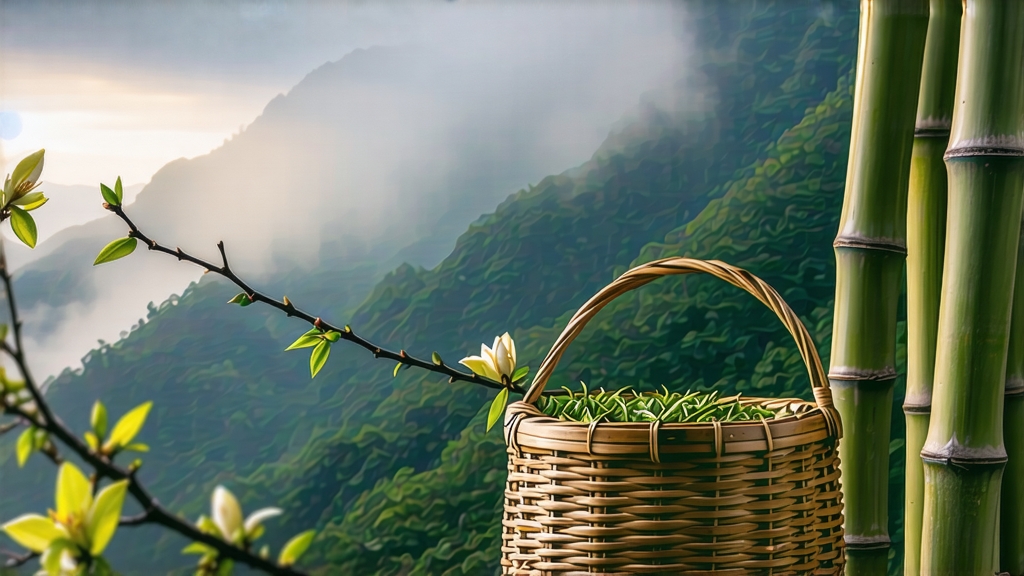
Tucked high on the northern rim of the Sichuan Basin, where perennial cloud banks press against the shoulders of Mt. Meng, a tiny golden bud has been quietly shaping the soul of yellow tea for twelve centuries. International drinkers may speak eloquently of Longjing or Da Hong Pao, yet inside China the three syllables Meng-ding-huang-ya still awaken the reverence once reserved for emperors. This essay invites you to travel beyond the panda postcards and chili heat normally associated with Sichuan, into a world of mineral springs, Buddhist cliff inscriptions, and a tea whose flavour lingers like the echo of a distant bell.
-
A leaf born of poetry and politics
The first written record appears in the Chronicle of Mengding compiled during the Tang dynasty (AD 810). A Buddhist monk named Wu Lizhen planted seven tea bushes on the summit, believing the altitude—1 450 m above sea level—brought him closer to the bodhisattva of wisdom. When the Tang court moved its capital to nearby Chengdu during the An Lushan rebellion, imperial censors tasted the local brew, noted its jade-yellow liquor and “sweet snow” fragrance, and listed it among the nineteen tributes exempt from land tax. By the Song dynasty the emperor’s tea-tribute office had coined the term ya-cha, “bud tea”, and specified that only leaves picked before the Qingming festival could bear the name Huangya. Thus Mengding Huangya became China’s earliest documented yellow tea, predating Junshan Yinzhen by roughly two hundred years. -
Micro-terroir inside the world’s thickest fog
Mt. Meng enjoys 290 misty days a year. The cloud curtain filters sunlight into a soft, diffused glow, slowing photosynthesis and stacking amino acids—especially L-theanine—in the tender buds. Night-time temperatures drop 8–10 °C, locking in floral volatiles while reducing bitter catechins. The soil is a crumbly shale-sand mix, rich in selenium and zinc leached from ancient marine sediments. Locals insist that the mountain’s thirty-two mineral springs weave through root zones like an underground acupuncture map, timing the bud’s burst with the first spring thunder. No other yellow tea enjoys this marriage of altitude, humidity and trace minerals; it is the chemical signature that chromatographers can spot blind. -
The men-huang ritual: making yellow without oxidation
Yellow tea’s identity rests on a unique step called men huang, “sealing yellow”, a gentle suffocation that nudges the leaf into a non-enzymatic browning without ever reaching the full oxidation of black tea. Mengding Huangya undergoes two rounds of men huang, each calibrated to the mountain’s daily barometric pressure.
Withering: Fresh buds are spread on hemp cloth in a shaded pavilion for 90 minutes; moisture falls from 76 % to 68 %, rendering the leaf supple enough for the next heat shock.
Pan-firing: A cast-iron wok is heated to 160 °C, then cooled to 120 °C within 40 seconds. The tea master tosses 250 g of buds in a figure-eight motion, using only the heel of his palm. The goal is “killing green” (enzyme deactivation) while preserving a 5 % residual moisture—higher than green tea, crucial for the yellowing to come.
First men huang: The warm leaf is immediately wrapped in steamed bamboo paper and slid into a hemp-lined cedar box. For three hours the core temperature hovers at 45 °C; chlorophyll quietly degrades into pheophytin, edges of the bud turn primrose, and a popcorn-like aroma signals the Maillard reaction.
Rolling: A light 5-minute roll shapes the bud into a slightly curved “sparrow’s tongue” without rupturing cell walls; this prevents the liquor from turning turbid.
Second men huang: The leaf rests again, this time for five hours inside a pottery jar buried in rice hulls. Ambient humidity climbs to 85 %, encouraging a secondary yellowing that deepens the colour and rounds the astringency.
Low-temperature drying: Finally the buds are dried in three ascending stages—60 °C, 80 °C, 55 °C—using charcoal made from local walnut wood. The total processing time stretches across 36 attentive hours, after which the leaf moisture is locked at 5